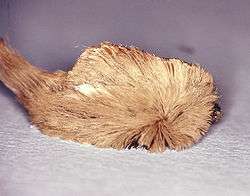Megalopyge opercularis
| Megalopyge opercularis | |
|---|---|
 | |
| Scientific classification | |
| Kingdom: | Animalia |
| Phylum: | Arthropoda |
| Class: | Insecta |
| Order: | Lepidoptera |
| Family: | Megalopygidae |
| Genus: | Megalopyge |
| Species: | M. opercularis |
| Binomial name | |
| Megalopyge opercularis (JE Smith, 1797) | |
Megalopyge opercularis is a moth of the family Megalopygidae. It has numerous common names, including southern flannel moth for its adult form, and puss caterpillar, asp, Italian asp, woolly slug, opossum bug,[1] puss moth, or asp caterpillar for its larval form.
Description
The inch-long larva is generously coated in long, luxuriant hair-like setae, making it resemble a tiny Persian cat, the characteristic that presumably gave it the name "puss". It is variable in color, from downy grayish white to golden brown to dark charcoal gray. It often has a streak of bright orange running longitudinally. The "fur" on early-stage larvae is sometimes extremely curly, giving the larva a cottony, puffed-up look. The body tapers to a tail that extends well beyond the body, unlike its relative M. crispata.[2] The middle instar has a more disheveled, "bad-hair-day" appearance, without a distinctive tail. The "fur" of the larva contains venomous spines that cause extremely painful reactions in human skin upon contact. The adult moth is covered in long fur in colors ranging from dull orange to lemon yellow, with hairy legs and fuzzy black feet.
Habitat
M. opercularis can be found on oaks, elms, wild plum among others, as well as many garden plants such as roses and ivy. It is distributed throughout the eastern United States between North Carolina and Florida, the southern United States, Mexico, and parts of Central America.[3]
Dangers and treatment of stings
The caterpillar is regarded as a dangerous insect because of its venomous spines. Exposure to the caterpillar's fur-like spines will lead to an immediate skin irritation characterised by a, "grid-like hemorrhagic papular eruption with severe radiating pain". The pain has been described by patients as similar to a broken bone or blunt force trauma.[1] The reactions are sometimes localized to the affected area but are often very severe, radiating up a limb and causing burning, swelling, nausea, headache, abdominal distress, rashes, blisters, and sometimes chest pain, numbness, or difficulty breathing.[4] Additionally, it is not unusual to find sweating from the welts or hives at the site of the sting.
Medical advice may be sought in case of contact with one. It is best if the venom from the spines is treated within hours of first contact. For first aid, it is recommended that the spines (if present) be removed by using cellophane tape.[4] Some remedies, which are reported to have varying degrees of success, include ice packs, oral antihistamine, baking soda, hydrocortisone cream, juice from the stems of comfrey plants, or calamine lotion.[4]
References
- 1 2 Eric W. Hossler (2009), "Caterpillars and moths", Dermatologic Therapy, 22 (4): 353–366, doi:10.1111/j.1529-8019.2009.01247.x
- ↑ Wagner, DL (2005), Caterpillars of Eastern North America., Princeton Univ. Press
- ↑ John P. McGovern; et al. (1961), "Megalopyge Opercularis: Observations of Its Life History, Natural History of Its Sting in Man, and Report of an Epidemic", J.A.M.A., 175: 1155–1158
- 1 2 3 Eagleman, DM (2007). "A Study of the Geographical Distribution and Symptoms of Envenomation by the Asp Caterpillar, Megalopyge opercularis" (PDF). Clinical Toxicology. 46 (3): 201–5. doi:10.1080/15563650701227729.
External links
| Wikimedia Commons has media related to Megalopyge opercularis. |
- Research on the Asp Caterpillar at Baylor College of Medicine
- Info page with photos
- BugGuide account
- Megalopyge opercularis on the UF / IFAS Featured Creatures website.

